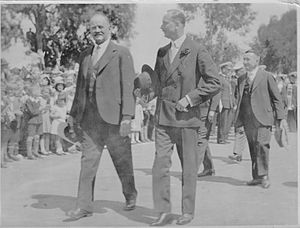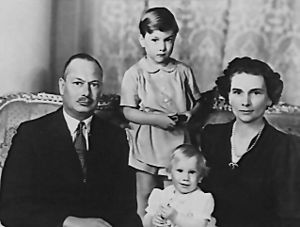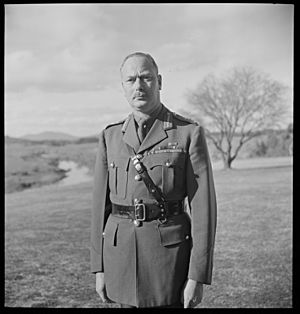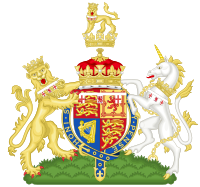Prince Henry, Duke of Gloucester facts for kids
Quick facts for kids Prince Henry |
|||||
|---|---|---|---|---|---|
| Duke of Gloucester | |||||
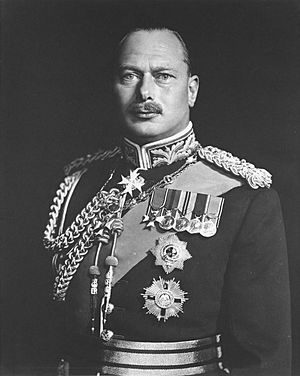
Prince Henry c. 1945
|
|||||
| 11th Governor-General of Australia | |||||
| In office | 30 January 1945 – 11 March 1947 | ||||
| Predecessor | The Lord Gowrie | ||||
| Successor | Sir William McKell | ||||
| Monarch | George VI | ||||
| Prime ministers | |||||
| Born | Prince Henry of York 31 March 1900 York Cottage, Sandringham |
||||
| Died | 10 June 1974 (aged 74) Barnwell Manor, Northamptonshire |
||||
| Burial | 14 June 1974 Royal Burial Ground, Frogmore |
||||
| Spouse | |||||
| Issue | |||||
|
|||||
| House | Windsor (after 1917) Saxe-Coburg and Gotha (before 1917) |
||||
| Father | George V | ||||
| Mother | Mary of Teck | ||||
| Military career | |||||
| Allegiance | |||||
| Service/ |
|||||
| Years of active service | 1919–37 | ||||
| Rank | Field Marshal | ||||
| Unit | King's Royal Rifle Corps 10th Royal Hussars British Expeditionary Force |
||||
| Battles/wars | Second World War | ||||
Prince Henry, Duke of Gloucester (born Henry William Frederick Albert; 31 March 1900 – 10 June 1974) was a member of the British royal family. He was the third son and fourth child of King George V and Queen Mary.
Prince Henry served as Governor-General of Australia from 1945 to 1947. He was the only member of the royal family to hold this important position. He was also the first son of a British monarch to go to school. He was very good at sports.
His military career was often interrupted by his royal duties. People sometimes called him "the unknown soldier" because he kept a low profile. In 1935, he married Lady Alice Montagu Douglas Scott. They had two sons, Princes William and Richard.
During World War II, Prince Henry served in France as a liaison officer. He carried out military and diplomatic duties throughout the war. In 1945, he became Australia's governor-general. This role was first offered to his younger brother, the Duke of Kent, who sadly died in a plane crash. Prince Henry attended the coronation of his niece Queen Elizabeth II in 1953. He also made several trips overseas, often with his wife.
From 1965, he became unwell due to several strokes. When he passed away, his only living son, Richard, became the Duke of Gloucester. Prince Henry was the last surviving child of King George V and Queen Mary. His wife, Princess Alice, lived to be 102 years old. She became the longest-living member of the British royal family ever.
Contents
Early Life and Family
Prince Henry was born on 31 March 1900. This was at York Cottage, on the Sandringham Estate. His great-grandmother, Queen Victoria, was still on the throne. His father was the Duke of York, who later became King George V. His mother was the Duchess of York, who later became Queen Mary.
When he was born, Henry was fifth in line to the throne. This meant he was behind his grandfather, father, and two older brothers. He was baptised at Windsor Castle on 17 May 1900. His family often called him Harry.
Childhood and School Days
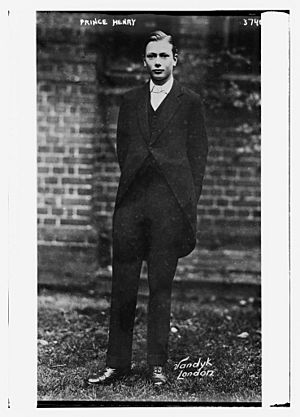
As a young boy, Prince Henry was not always healthy, much like his older brother Albert. He had "knocked knees" and had to wear special leg splints. He was also a very shy child. Henry had some speech difficulties. He found it hard to say the "r" sound, and his voice was quite high-pitched.
By 1909, his parents were worried about his health. He was small for his age and often caught bad colds. His father, King George V, decided it would be good for Henry to go to school. This would help him interact with other boys his age. Prince Henry was the first son of a British monarch to attend school.
He spent three years at St Peter's Court in Broadstairs. Henry was not the best at schoolwork, but he was very good at mathematics. His main interest was sports, especially cricket and football. His mother sometimes joked about how much he wrote about football.
In September 1913, Henry started at Eton College. During the First World War, Crown Prince Leopold of Belgium was in his house. Henry's schoolwork did not get much better, but he became less nervous. He made friends through sports. His teachers were happy with him, saying he was "thoroughly willing, cheerful, modest & obedient." His father thought these qualities were very important.
In 1919, Henry went to Trinity College, Cambridge with his brother Albert. By this time, Henry was taller and bigger than all his brothers. He was also in very good health. They stayed at Cambridge for one year.
Military Service
Unlike his brothers, Prince Henry joined the Army. He went to the Royal Military College, Sandhurst in 1919. He became a second lieutenant in the King's Royal Rifle Corps. In 1921, he was promoted to lieutenant in the 10th Royal Hussars. He wanted to be an active soldier, but his role as a royal family member limited this.
He was promoted to captain in 1927. He became a personal aide to his father, King George V, in 1929. In 1934, he was made a major. In 1935, he became a full major, which was his last rank as an active officer. After his brother Edward VIII stepped down, and his brother Albert became George VI, Prince Henry was mostly retired from active duty. He received a ceremonial promotion to major-general in 1937.
When World War II started, he joined the British Expeditionary Force. He was a Chief Liaison Officer in France. He was slightly injured in 1940 when his car was attacked from the air. In 1941, he was promoted to lieutenant-general. In 1944, he became a full general. He was later made a Field Marshal in 1955 and a Marshal of the Royal Air Force in 1958.
Becoming the Duke of Gloucester

On 31 March 1928, his father gave him the titles of Duke of Gloucester, Earl of Ulster, and Baron Culloden. These titles connected him to different parts of the United Kingdom: England, Northern Ireland, and Scotland. Prince Henry visited Canada in 1928.
Before he got married, Prince Henry really wanted to command his regiment, the 10th Royal Hussars. But as the King's son, he could not join his regiment abroad. This made him feel like an outsider among his fellow officers. He also had to do many royal duties for his father.
In September 1928, Henry went to Africa with his brother Edward, the Prince of Wales, to hunt big game. In Nairobi, he met Beryl Markham. The King thought that keeping Henry busy would be the best way to help him. So, he arranged many tours for his son.
In 1929, he went to Japan to present an award to the Emperor. A year later, he attended the coronation of Haile Selassie of Ethiopia in Addis Ababa. In 1934, King George V made him a Knight of St Patrick. This was a special award for Ireland. He was the last person to hold this title when he died. In 1934, he also visited Australia and New Zealand. People there were very excited to see him.
He represented Queen Elizabeth II when Malaya became independent on 31 August 1957.
Marriage and Family Life
After his trip to Australia and New Zealand, and with encouragement from his parents, Prince Henry decided to marry. He proposed to Lady Alice Montagu Douglas Scott. She was the sister of one of Henry's good friends. They were married on 6 November 1935. The wedding was held at Buckingham Palace.
After two miscarriages, the Duchess of Gloucester gave birth to two sons:
- Prince William of Gloucester (born 18 December 1941 – died 28 August 1972)
- Prince Richard, Duke of Gloucester (born 26 August 1944). He married Birgitte van Deurs in 1972. They had three children.
The couple first lived at the Royal Pavilion in Aldershot. In 1938, the Duke bought Barnwell Manor. Their home in London was York House in St James's Palace.
Changes After Edward VIII's Abdication
In December 1936, Henry's brother Edward VIII decided to step down as King. He wanted to marry Wallis Simpson, who had been divorced. His younger brother, Prince Albert, then became King George VI. Prince Henry was now third in line to the throne, after his two nieces, Princesses Elizabeth and Margaret. This meant he would become regent if anything happened to the King before Princess Elizabeth turned 18.
Because of this, Prince Henry could not leave the UK at the same time as the King. He and his younger brother, the Duke of Kent, had to do many more royal duties to support the new King. Edward VIII, who became the Duke of Windsor, said that Henry reacted the least to the news of his abdication. The brothers were not very close.
The new King George VI told his younger brothers that they needed to take their royal duties more seriously. The Duke of Gloucester supported his brother and later his niece, Queen Elizabeth II, very faithfully. King George VI trusted Prince Henry with important tasks.
Serving in World War II
After World War II began, the Duke of Gloucester spent almost the entire first year of the war in France. He was the Chief Liaison Officer to Lord Gort. He helped boost the spirits of the troops. He also gave important reports to government officials and the King about what was happening.
The Duke was always keen to be involved and often found himself in dangerous situations. He did not seem too worried. He wrote to his wife that "Motoring about is not nice as many villages are being bombed." In May 1940, he had two very close calls.
He wanted to meet King Leopold III of Belgium to offer support. On 14 May, he drove into Belgium to see the King. That night, the hotel where he had been staying was bombed. Many people died, including those in rooms next to his. As the Duke drove back, his car caught fire during heavy bombing. He managed to escape, but he was injured and needed medical help.
In June, after the fall of Dunkirk, the Duke was ordered back to England. He joked to his mother that "Wherever I went or had been, I was bombed."
In early 1942, the King sent the Duke on a four-month military and diplomatic trip to the Middle East, India, and East Africa. This was a dangerous trip. The King even said he would look after Prince William, Henry's newborn son, if anything happened to his brother. After Prince Henry's younger brother, the Duke of Kent, died in a plane crash in August 1942, it was decided that the Duke of Gloucester would not be sent on any more dangerous missions.
Governor-General of Australia
In late 1944, the Duke was chosen to be Governor-General of Australia. This happened after his younger brother, the Duke of Kent, who had been offered the job, died in 1942.
The Duke had visited Australia in 1934 and it was a great success. He was a shy person, so he sometimes seemed a bit formal. But he and the Duchess traveled all over Australia using his own plane. When Prime Minister Curtin died in 1945, the Duke appointed Frank Forde as the new prime minister.
Prince Henry left Australia in March 1947. He had served for two years. He needed to return to the UK to act as a Senior Counsellor of State. This was because King George VI and Princesses Elizabeth and Margaret were visiting South Africa. As a goodbye gift, he left his plane for the Australian government and people to use.
Later Years
From 1949 to 1963, the Duke served as the Lord High Commissioner to the General Assembly of the Church of Scotland several times.
The Duke attended the coronation of his niece Elizabeth II in 1953. Both the Duke and Duchess carried out many royal duties, including trips overseas. In his later years, he suffered several strokes. His first stroke was in 1965. This, along with later strokes, meant he needed a wheelchair and could not speak in his final years.
His last public appearance was in 1967. In 1972, he was too unwell to attend the funeral of the Duke of Windsor or his younger son Prince Richard's wedding. In August, his older son, Prince William, died in a plane crash. He was so unwell that his wife was unsure whether to tell him. She later wrote that she did not tell him directly, but he might have learned about it from television.
Death
Prince Henry died on 10 June 1974, at 74 years old. He was the last surviving child of King George V and Queen Mary. He was buried at the Royal Burial Ground, Frogmore.
His second and only living son, Prince Richard, inherited the title of Duke of Gloucester. His wife, Alice, was given permission by Queen Elizabeth II to be called Princess Alice, Duchess of Gloucester. This was to distinguish her from Prince Richard's wife. She lived for 30 years after her husband, passing away on 29 October 2004, at the age of 102. She became the longest-living member of the British royal family in history.
Titles and Awards
Titles and Styles
- 1900–1901: His Royal Highness Prince Henry of York
- 1901: His Royal Highness Prince Henry of Cornwall and York
- 1901–1910: His Royal Highness Prince Henry of Wales
- 1910–1928: His Royal Highness The Prince Henry
- 1928–1974: His Royal Highness The Duke of Gloucester
Honours and Awards
Prince Henry received many honours and awards throughout his life, including:
- KG: Knight of the Order of the Garter (1921)
- KT: Knight of the Order of the Thistle (1933)
- KP: Knight of the Order of St Patrick (1934)
- GCB: Great Master and Principal Knight Grand Cross of the Order of the Bath (1942)
- GCMG: Knight Grand Cross of the Order of St Michael and St George (1935)
- GCVO: Knight Grand Cross of the Royal Victorian Order (1922)
- GCStJ: Grand Prior of the Order of St John (1939)
- Royal Victorian Chain (1932)
- From Norway: Grand Cross with Collar of the Order of St. Olav (1924)
- From Japan: Grand Cordon of the Order of the Chrysanthemum (1921); Collar (1929)
- From Denmark: Knight of the Order of the Elephant (1924)
- From France: Grand Cross of the Legion of Honour (1927)
- From Siam: Knight of the Order of the Royal House of Chakri (1939)
- From Sweden: Knight of the Order of the Seraphim (1956)
- From Italy: Grand Cross of the Order of Merit of the Italian Republic (1958)
Military Appointments
He held several important military roles:
- Colonel in Chief, Gloucestershire Regiment
- Colonel in Chief, Royal Inniskilling Fusiliers
- Colonel, Ceylon Light Infantry (1937)
- Colonel, Scots Guards (1937)
- Colonel in Chief, Royal Army Service Corps
- Colonel in Chief, Royal Corps of Transport
Coat of Arms
In 1921, Prince Henry was given his own special coat of arms. It was based on the royal arms, but with a unique design to show it belonged to him.
|
|
|
|
See also
 In Spanish: Enrique de Gloucester para niños
In Spanish: Enrique de Gloucester para niños



